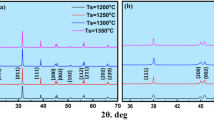Abstract
A number of zirconia-based materials show promise as electrode materials in magnetohydrodynamic (MHD) generators. As a part of an exploratory programme to find suitable materials for graded electrode applications in MHD generators, partially stabilized and fully stabilized sintered ceramic materials are prepared and characterized. The oxygen ion transference number t ion(O2−) and electrical conductivity of this material are measured up to 1670 K in the oxygen partial pressure range 1 to 10−6 atm. The activation energies for conduction are determined. The electrical properties of this material are characterized by mixed conduction, ionic and electronic. The observed conductivity data are explained in terms of the defect equilibrium reactions between tetravelent Ce4+ and trivalent Ce3+ ions.
Similar content being viewed by others
References
J. B. Heywood and G. J. Womack, “Open Cycle MHD Power Generation” (Pergamon, Oxford, 1969), p. 535.
J. Teno, in Proceedings of 8th International Symposium on Engineering Aspects of MHD, Stanford University, March 1967.
J. Millet and M. Guillou, J. Chim. Phys. 64 (1967) 1726.
D. B. Meadowcraft, J. Mater. Sci. 4 (1969) 768.
Ya. P. Gokhsteyn, A. Safonov and V. Lyvbinov, “The MHD Method of Producing Electrical Energy” (Energia, Moscow, 1968).
B. R. Rossing, L. H. Cadoff and T. K. Gupta, in Proceedings of 6th International Conference on MHD Electrical Power Generation, Washington, DC, 1975, Vol. 2, p. 105.
F. A. Akhopov, V. G. Gorden, V. V. Osika, A. I. Rekov, V. E. Serebrennikova and G. R. Cheryshov, in Proceedings of 6th International Conference on MHD Electrical Power Generation, Washington DC, 1975, Vol. 2, p. 129.
V. Longo and L. Podda, Ceramurgia 11 (1971) 11.
M. Forestier, G. Robert, M. Caillet and C. Desportes, Mater. Res. Bull. 4 (1969) 727.
R. C. Garvie and P. Nicholson, J. Amer. Ceram. Soc. 55(3), (1972) 152.
R. G. Cooke and P. Popper, “Special Ceramics 6” (British Ceramic Research Association, 1975) p. 135.
F. A. Kröger and H. J. Vink, in “Solid State Physics”, edited by F. Seitz and D. Turnbull (Academic, New York, 1956) p. 307.
J. Millet, M. Gluillou and S. Palous, Electrochim. Acta 13, (1968) 1425.
W. D. Kingery, J. Pappis, M. E. Doty and D. C. Hill, J. Amer. Ceram. Soc. 42 (1959) 393.
W. H. Strehlow and E. L. Cook, J. Phys. Chem. Ref. Data 2 (1973) 163.
E. J. W. Verway, P. W. Haaijman, F. C. Romeijn and G. W. Van Oosterhout, Philips Res. Rep. 5 (1950) 173.
P. Kofstad and A. Z. Hedd, J. Amer. Ceram. Soc. 50 (1967) 681.
Author information
Authors and Affiliations
Rights and permissions
About this article
Cite this article
Patil, D.S., Venkatramani, N. & Rohatgi, V.K. Electrical conductivity of (ZrO2)0.85(CeO2)0.12 (Y2O3)0.03 . J Mater Sci 23, 3367–3374 (1988). https://doi.org/10.1007/BF00551320
Received:
Accepted:
Issue Date:
DOI: https://doi.org/10.1007/BF00551320




